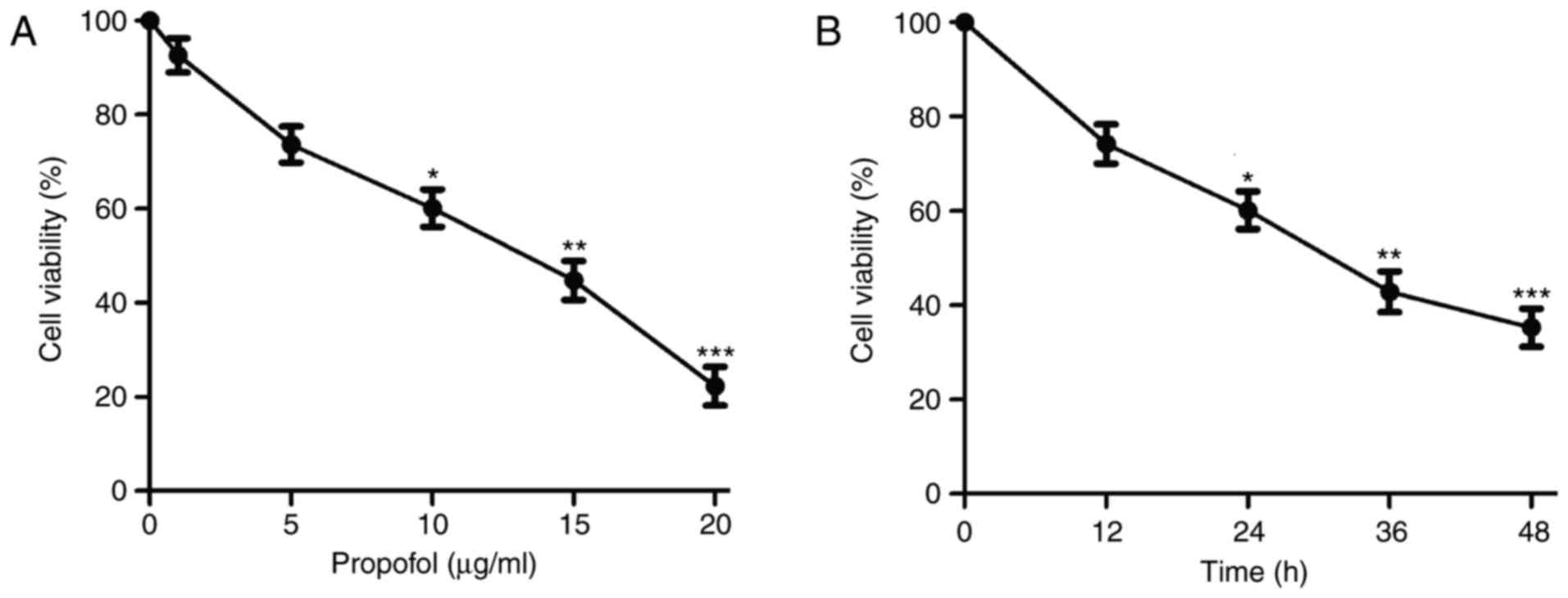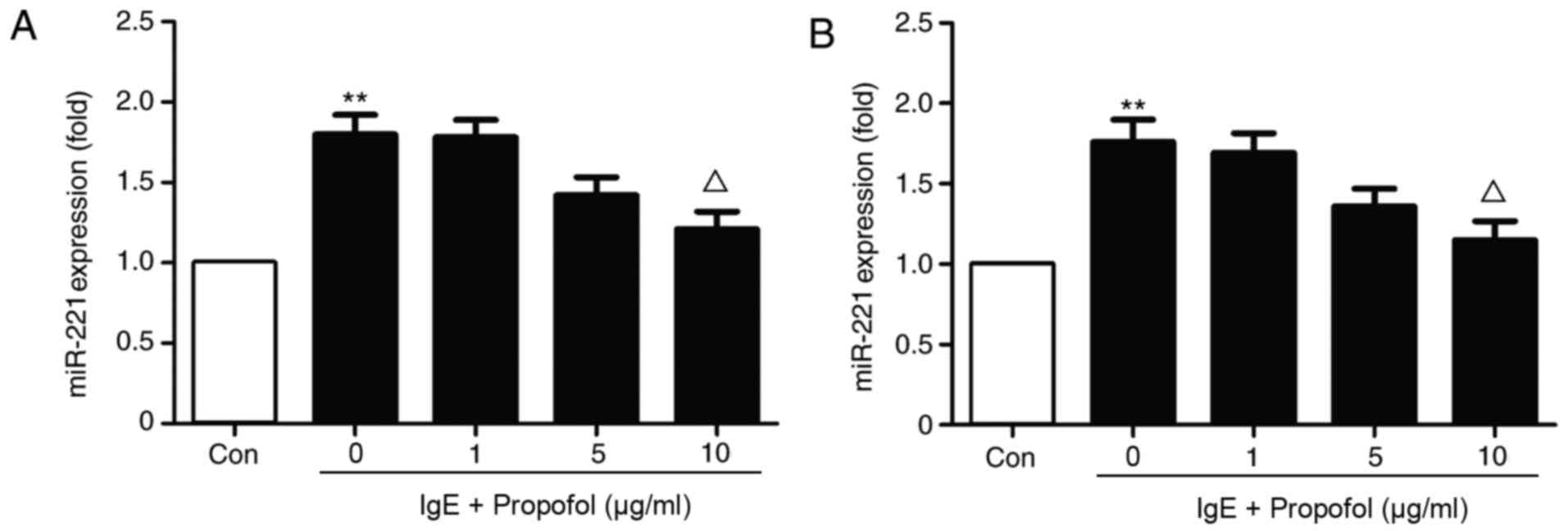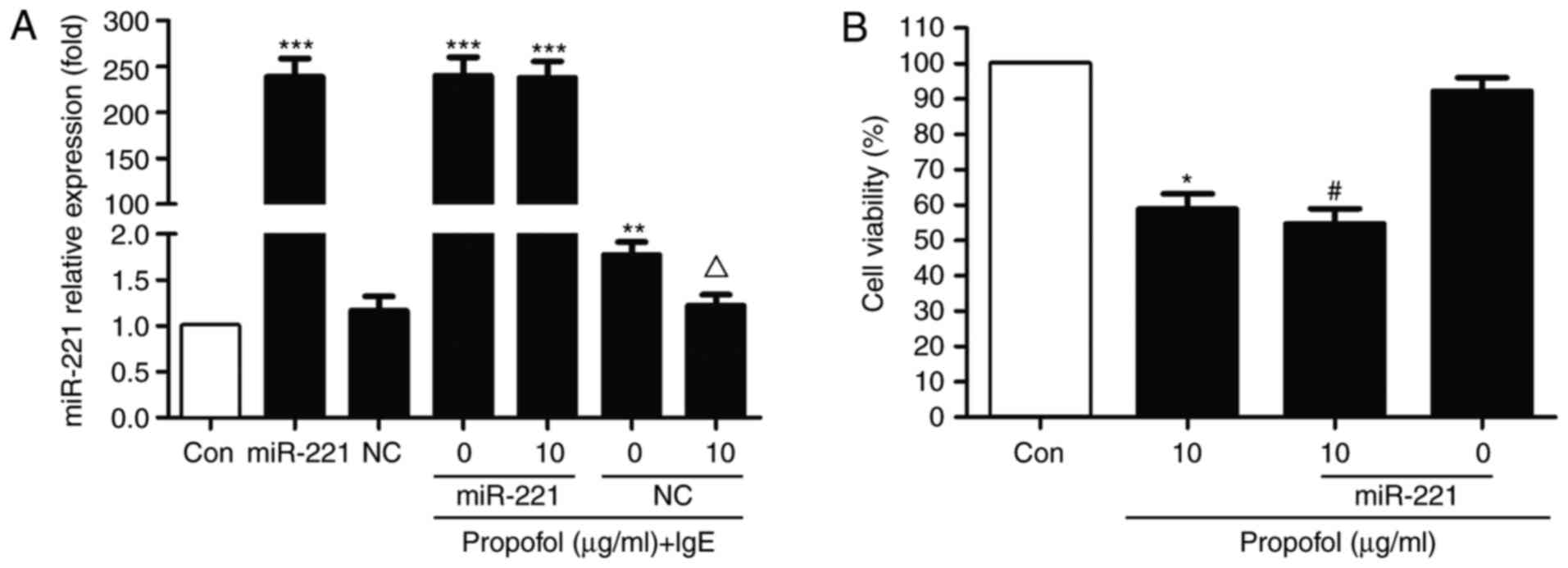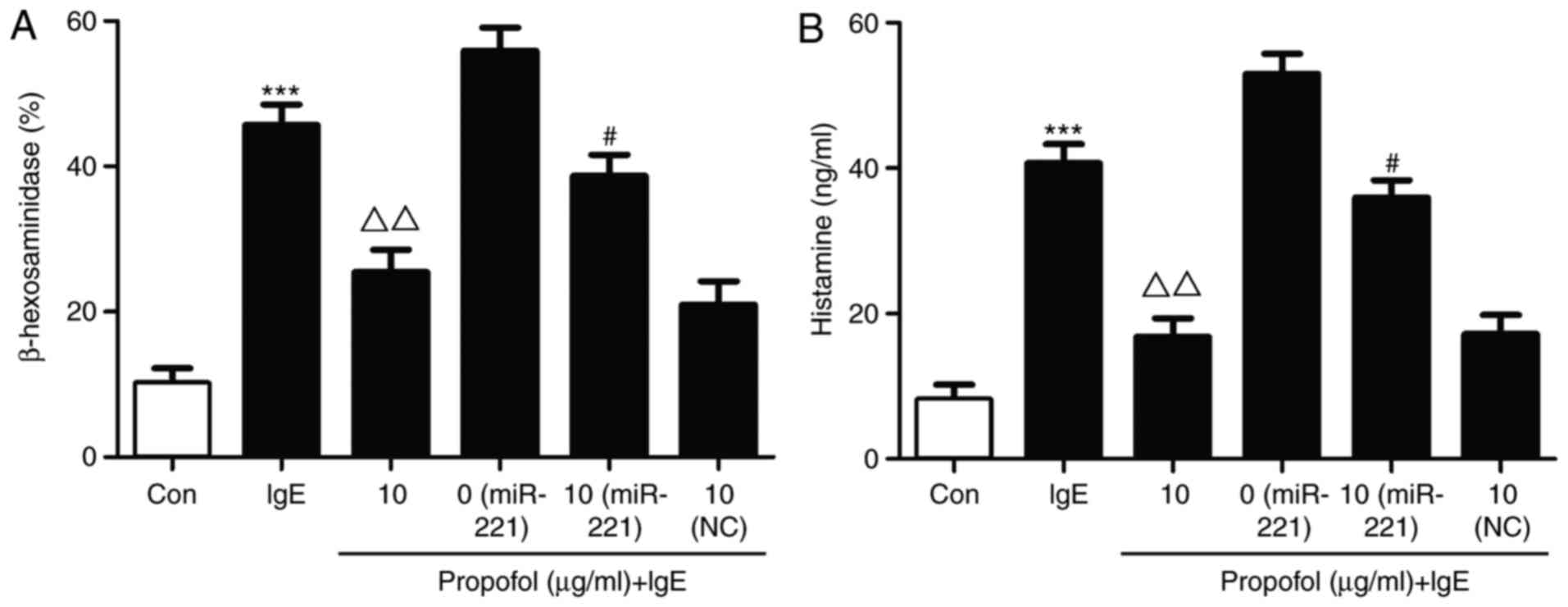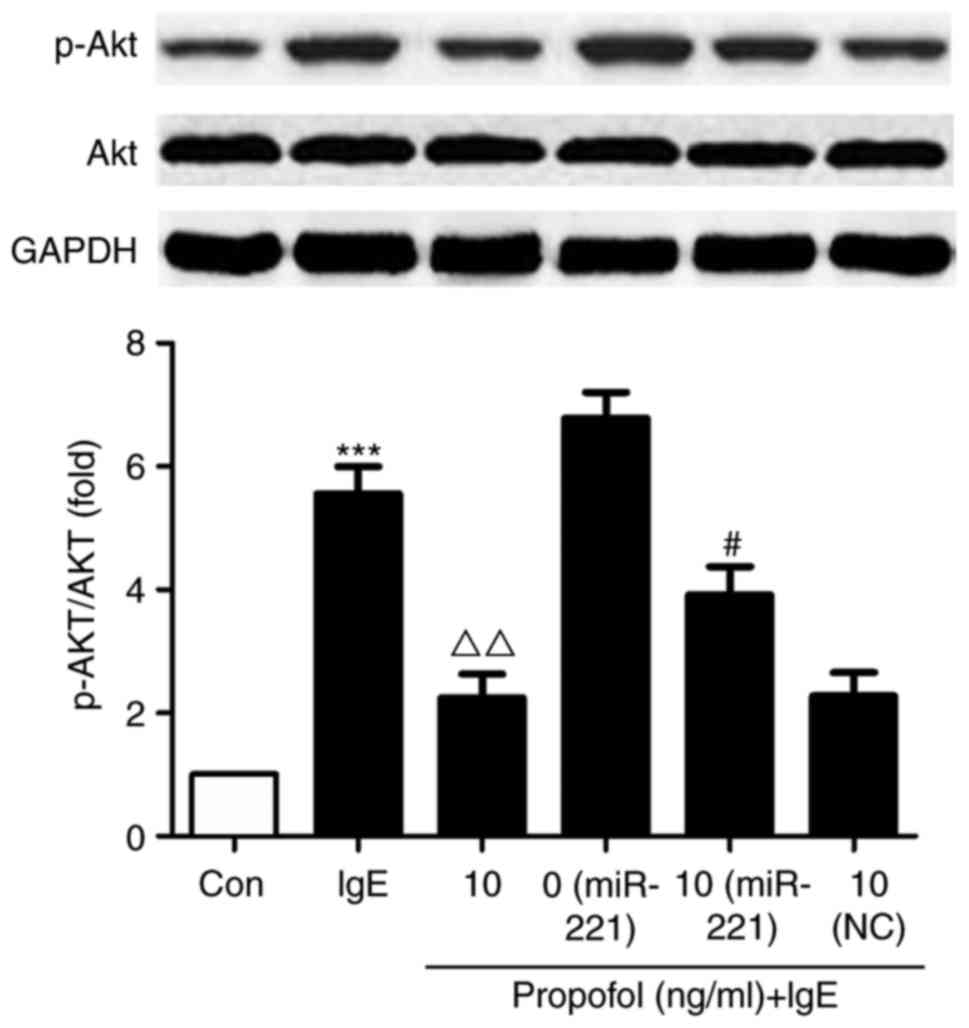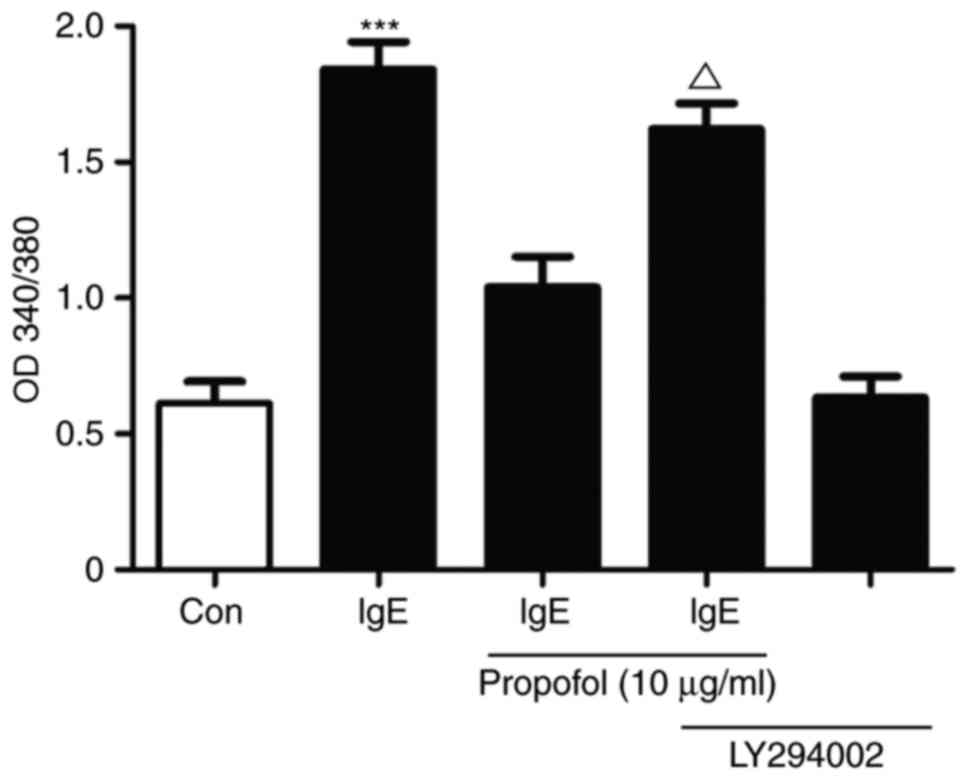Propofol attenuates mast cell degranulation via inhibiting the miR‑221/PI3K/Akt/Ca2+ pathway
- Authors:
- Published online on: June 15, 2018 https://doi.org/10.3892/etm.2018.6317
- Pages: 1426-1432
Abstract
Introduction
Mast cells are widely distributed in sites around the body, including the skin, airways, gastrointestinal tract and mucosa, and are able to quickly respond to internal and external stimuli (1). Mast cells secrete a number of bioactive mediators, including proteases, cytokines, chemokines, β-hexosaminidase and histamine, which are associated with the regulation of innate and acquired immune responses (2). Mast cells serve a crucial role in allergic disorders, including asthma, atopic dermatitis and hypersensitivity (3), and are associated with the allergy-induced inflammatory responses (4). Mast cells present the high-affinity immunoglobulin E (IgE) receptor (FcεRI) on their surface, which is able to bind IgE and induce mast cell degranulation following repeated-allergen stimulation (5). During the degranulation process, mast cell-induced mediators are controlled by FcεRI-dependent signaling pathways, including phosphoinositide3-kinase (PI3K) family members (6). However, the underlying mechanisms responsible for mast cell degranulation are complex and remain to be fully elucidated.
Propofol is a widely used intravenous anesthetic agent with rapid onset, short duration of action and rapid elimination (7). A number of pharmacological characteristics of propofol have been reported, including antipruritic, anti-convulsant, anti-oxidant and anti-inflammatory activities (8). Furthermore, propofol has been demonstrated to inhibit adhesion, proliferation, invasion and growth in various cancers, including ovarian cancer, hepatocellular carcinoma, pancreatic cancer, glioma and lung cancer (9–13). The anti-cancer effect of propofol is typically associated with an upregulation or downregulation of microRNA (miR or miRNA) (9,11,13). A previous study indicated that propofol treatment attenuated ischemia reperfusion injury in the small intestine via inhibiting oxidative stress and mast cell degranulation (14), suggesting that propofol may function by modulating mast cell activation. However, the underlying molecular mechanisms remain unclear.
The aim of the present study was to investigate the effect of propofol on IgE-activated mast cell degranulation and the underlying mechanisms. The results indicate that propofol acts via the miR-221/PI3K/protein kinase B (Akt)/Ca2+ pathway to suppress mast cell activation, which suggests a possible target for treating allergic diseases via inhibiting IgE-mediated mast cell degranulation.
Materials and methods
Reagents
Propofol, LY294002, dimethyl sulfoxide (DMSO), MTT, anti-2,4-dinitrophenyl (DNP) IgE and DNP-human serum albumin (HSA) were purchased from Sigma Aldrich (Merck KGaA, Darmstadt, Germany. Dulbecco's modified eagle medium (DMEM), TRIzol, Lipofectamine® 2000 andfura-2/AM were obtained from Invitrogen (Thermo Fisher Scientific, Inc., Waltham, MA, USA). Fetal bovine serum (FBS), penicillin and streptomycin were obtained from Gibco (Thermo Fisher Scientific, Inc.). The TaqMan MicroRNA Reverse Transcription kit and TaqMan MicroRNA Assay kit were acquired from Applied Biosystems (Thermo Fisher Scientific, Inc.). ELISA kits (β-hexosaminidase cat. no. KT-17547; histamine cat. no. KT-60094) were purchased from Kamiya Biomedical Co. (Tukwila, WA, USA). Lysis buffer was obtained from Cell Signaling Technology, Inc. (Danvers, MA, USA) and the BCA Protein Assay kit was acquired from Pierce (Thermo Fisher Scientific, Inc.). Rabbit anti-rat antibodies against Akt (cat. no. SC-8312), phosphorylated (p)-Akt (s473) (cat. no. SC-33437), GAPDH (cat. no. SC-25778) and horseradish peroxidase (HRP)-conjugated goat anti-rabbit secondary antibodies (cat. no. SC-2030) were purchased from Santa Cruz Biotechnology, Inc. (Dallas, TX, USA). Unless otherwise stated, other reagents were purchased from Sigma Aldrich (Merck KGaA).
RBL-2H3 cell culture and propofol treatment
Rat basophilic leukemia RBL-2H3 cells were purchased from the Cell Bank of the Chinese Academy of Sciences (Shanghai, China). Cells were cultured in DMEM containing with 10% heat-inactivated FBS, 100 IU/ml penicillin and 100 µg/ml streptomycin at 37°C in a humidified incubator containing 5% CO2. Propofol was diluted with DMSO to obtain indicated concentrations (5, 10, 15 or 20 µg/ml) and was added to the cells for the indicated time (12, 24, 36 or 48 h).
The original RBL-2H3 cells were cultured in 12-well plates at a density of 1×106 cells/well. After 24 h following propofol treatment, 2×105 RBL-2H3 cells from each treatment group were collected for further analysis. Cells without propofol treatment or IgE stimulation were used as the control (Con) group.
MTT assay
Cell viability was analyzed using an MTT assay. RBL-2H3 cells were seeded in 96-well plates and treated with propofol as described. A total of 5 mg/ml MTT was added to the plates and incubated at 37°C for 4 h. DMSO was added to dissolve the formazan crystals. Optical density (OD) was measured at 590 nm using a microplate reader (Bio-Rad Laboratories, Inc., Hercules, CA, USA). The inhibitory rate of cell proliferation (%) was measured using following formula: (OD of control group-OD of test group) ×100/OD of control group (Table I).
Activation of mast cell degranulation
RBL-2H3 cells were sensitized with 0.5 µg/ml anti-DNP IgE overnight at 37°C to induce IgE-mediated allergic responses. Cells were subsequently stimulated with 100 ng/ml DNP-HSA at 37°C for 4 h to activate the degranulation of mast cells.
Reverse transcription-quantitative polymerase chain reaction (RT-qPCR)
Total RNA was extracted using TRIzol and RT was performed with a TaqMan MicroRNA Reverse Transcription kit according to the manufacturers' protocol (16°C for 30 min, 42°C for 30 min and 85°C for 5 min). To detect miR-221 expression, qPCR was performed using the 7500 Fast Real-Time PCR System (Thermo Fisher Scientific, Inc.) with TaqMan MicroRNA Assay kit. The thermocycling conditions were as follows: 95°C for 2 min followed by 40 cycles of 95°C for 15 sec, 55°C for 30 sec, and 60°C for 1 min. The following primers were purchased from Shanghai GenePharma Co., Ltd., (Shanghai, China): miR-221, forward 5′-CCCAGCATTTCTGACTGTTG-3′ and reverse 5′-TGTGAGACCATTTGGGTGAA-3′; U6, forward 5′-CAAGGATGACACGCAAAT-3′ and reverse 5′-TGGTGTCGTGGAGTCG-3′. The expression of U6 was used as endogenous control for miRNAs analysis. Data were analyzed by the 2−ΔΔCq method (15).
Transfection
RBL-2H3 cells were transfected with miR-221 mimic (5′-AGCUACAUUGUCUGCUGGGUUUC-3′) and its negative control (5′-UCACAACCUCCUAGAAAGAGUAGA-3′; both from Shanghai GenePharma Co., Ltd.) using Lipofectamine® 2000 reagent according to the manufacturer's protocol. The final concentration of oligonucleotides was 50 nM. Cells were subjected to RNA/protein extraction or further experiments at 24 h following transfection.
Detection of β-hexosaminidase release
Following the activation of mast cell degranulation, the cells were separated by centrifugation at 150 × g for 5 min at 4°C and then the supernatants were incubated in citrate buffer with 1 mM 4-nitrophenyl N-acetyl-β-D-glucosaminide at 37°C for 1 h. Cell pellets were lysed with Tyrode's buffer containing 1% Triton X-100 and the reaction was stopped by adding 150 µl stop solution (0.1 M Na2CO3-NaHCO3; pH=10). Absorbance was measured at 405 nm using the microplate reader (ELX808; BioTek Instruments, Inc., Winooski, VT, USA).
Analysis of histamine release
The levels of histamine in the supernatants of RBL-2H3 cells were measured using the ELISA kit according to the manufacturer's protocol.
Western blotting
RBL-2H3 cells were collected and lysed using lysis buffer containing protease and phosphatase inhibitors on ice. Following centrifugation at 400 × g for 5 min at 4°C, the supernatants were collected. The protein concentrations in the supernatants were measured using a BCA Protein Assay kit. Proteins (20 µg) were separated by electrophoresis with 10% SDS-PAGE gel and transferred onto polyvinylidene fluoride membranes. Membranes were blocked with 5% skim milk at 37°C for 2 h and incubated with the primary rabbit anti-rat antibodies against Akt, p-Akt (s473) and GAPDH overnight at 4°C. Membranes were then incubated with HRP-conjugated goat anti-rabbit secondary antibodies. Bands were visualized using enhanced chemiluminescence detection kit (ECL; GE Healthcare, Chicago, IL, USA) and scanned for analysis (Scanjet 7400C; Hewlett-Packard Co., Palo Alto, CA, USA).
Cytosolic calcium (Ca2+) measurement
The supernatants of RBL-2H3 cells were collected and incubated in Tyrode's buffer supplemented with fura-2/AM (2 µM final concentration) at 37°C for 30 min. Absorbance was measured at 340 and 380 nm using a microplate fluorometer (Berthold Technologies GmbH & Co., Bad Wildbad, Germany) and the intracellular Ca2+ was shown as the 340/380 ratio.
Statistical analysis
Results are presented as the mean ± standard deviation. All statistical analysis was performed using SPSS software (version 13.0; SPSS, Inc., Chicago, IL, USA). For multiple comparisons of quantitative data, one-way analysis of variance was used followed by Bonferroni's post hoc test. P<0.05 was considered to indicate a statistically significant difference.
Results
Propofol suppresses the proliferation of RBL-2H3 cells
Following treatment with various concentrations of propofol, the proliferation of RBL-2H3 cells was significantly suppressed in a dose-dependent manner compared with the control (Fig. 1A). As the IC50 was 13.380 µg/ml (Table I), 10 µg/ml of propofol was selected as the highest concentration in further experiments. Propofol treatment also resulted in a time-dependent reduction in cell viability compared with the control (Fig. 1B). These results suggest that propofol inhibits RBL-2H3 cell proliferation in a dose- and time-dependent manner. Treatment duration of 24 h was selected for subsequent experiments.
Propofol inhibits miR-221 expression in RBL-2H3 cells
Treatment with 10 µg/ml propofol significantly reduced miR-221 expression in IgE-activated RBL-2H3 cells (Fig. 2A). The results indicate that propofol inhibits miR-221 expression in a dose-dependent manner. Because propofol was demonstrated to inhibit the proliferation of RBL-2H3 cells, miR-221 expression was also detected in the same number of RBL-2H3 cells obtained from a different group (Fig. 2B). The results suggest that miR-221 downregulation was independent of the decrease in RBL-2H3 cells following propofol application.
miR-221 has no significant effect on RBL-2H3cell proliferation
To investigate whether miR-221 is associated with the action of propofol in RBL-2H3 cells, an miR-221 overexpression model was constructed via transfection with miR-221 mimics. miR-221 notably abrogated the inhibitive effect of propofol in IgE-activated RBL-2H3 cells (Fig. 3A). However, no significant difference was observed compared with the NC group. Furthermore, following transfection with miR-221, cell viability was markedly reduced compared with the control. No statistical differences were observed in the presence of propofol, suggesting that miR-221 has no effect on RBL-2H3 cell proliferation (Fig. 3B).
miR-221 and the effect of propofol on mast cell degranulation
β-hexosaminidase and histamine release are typically used as indicators of mast cell granulation (16). In the present study, β-hexosaminidase and histamine release were significantly increased in the miR-221 overexpression group compared with the IgE stimulated group (Fig. 4). Following propofol treatment, β-hexosaminidase release was obviously decreased. However, miR-221 overexpression markedly restored the suppressive effect of propofol on β-hexosaminidase in IgE-stimulated mast cell degranulation (Fig. 4A). Similar results were observed for histamine (Fig. 4B).
miR-221-induced PI3K/Akt signaling is associated with the suppressive effect of propofol
Compared with the control group, Akt phosphorylation was significantly increased in IgE-activated RBL-2H3 cells. However, treatment with propofol significantly reduced Akt phosphorylation compared with cells treated with IgE alone (Fig. 5). miR-221 overexpression significantly reversed the suppressive effect of propofol on PI3K/Akt signaling, suggesting that miR-221 inhibits propofol via targeting its mechanistic pathway.
Decreased Ca2+ influx regulates the effects of propofol in mast cell degranulation
As Ca2+ is associated with mast cell degranulation, fura-2 induced changes in Ca2+ were measured. Ca2+ influx was significantly upregulated in IgE-activated RBL-2H3 cells. However, propofol treatment significantly inhibited Ca2+ influx (Fig. 6A). Furthermore, miR-221 treatment was able to reverse the suppressive effect of propofol (Fig. 6B), suggesting that Ca2+ participates in the regulation of propofol in mast cell degranulation.
Propofol attenuates mast cell degranulation via inhibiting the miR-221/PI3K/Akt/Ca2+ pathway
The association between PI3K/Akt signaling and Ca2+ influxwas investigated in propofol-treated IgE-mediated mast cell activation (Fig. 7). Treatment with propofol reduced Ca2+ influx in activated RBL-2H3 cells compared with the control cells. LY294002, a specific PI3K inhibitor, reversed the propofol-induced reduction in Ca2+ influx, suggesting that propofol attenuates mast cell degranulation via inhibiting the miR-221/PI3K/Akt/Ca2+ pathway (Fig. 7).
Discussion
Although propofol has been demonstrated to have anti-oxidant, anti-inflammatory and anti-tumor properties, few studies have investigated the effect of propofol on mast cell degranulation (8). The results of the present study demonstrate that propofol is able to affect RBL-2H3 cell proliferation, reduce miR-221 expression, suppress the release of β-hexosaminidase and histamine, limit activation of the PI3K/Akt signaling pathway and decrease Ca2+ influx in mast cells. These findings suggest that propofol may have potential as an anesthetic for surgical procedures associated with allergic responses.
MicroRNAs (miRs) are a group of small, single-stranded non-coding RNAs that regulate gene expression at the post-transcriptional level (17). Through binding to the 3′-untranslated region of target mRNAs, miRs are able to induce mRNA degradation or translational inhibition (18). miR-221 has been reported to be associated with the modulation of mast cell degranulation (19). A previous study demonstrated that miR-221 influenced the cell cycle, the extent of degranulation, cytokine production and the actin cytoskeleton in activated bone marrow-derived mast cells (20). It has been indicated that miR-221, which was overexpressed in a murine asthma model, is able to stimulate interleukin-4 secretion in mast cells through a pathway involving phosphatase and tensin homolog, p38 and nuclear factor (NF)-Κb (21). In line with these results, propofol treatment inhibited miR-221 expression in IgE-stimulated RBL-2H3 cells, suggesting that miR-221 may serve a role in the suppressive effect of propofol. These results were further confirmed by cell transfection with the miR-221 mimic.
The effect of PI3K/Akt signaling in mast cells has previously been investigated (22,23), as has the association between miR expression and PI3K/Akt signaling in mast cell degranulation (24,25). Although miR-223 expression was upregulated in IgE-mediated mast cells, miR-223 downregulation was demonstrated to promote mast cell degranulation and apoptosis via the PI3K/Akt pathway by targeting insulin-like growth factor 1 receptor in mast cells (25,26). Helicobacter pylori neutrophil-activating protein induced the release of histamine and interleukin-6 in human mast cell line-1 via the G protein-mediated mitogen-activated protein kinase (MAPK) and PI3K/Akt pathways (27). These studies indicated that PI3K/Akt signaling is associated with the regulation of mast cell activation, which may contribute to the inhibitive biological properties of propofol. The results of the present study also confirmed that propofol treatment restricted mast cell degranulation, as evidenced by the downregulation of β-hexosaminidase and histamine. Propofol treatment results in decrease Akt phosphorylation, suggesting that the PI3K/Akt signaling pathway serves a role in the suppressive effect of propofol on mast cell degranulation.
Generally, mast cell activation results in the degranulation of preformed mediators, including histamine, and the secretion of newly synthesized mediators, including leukotrienes and inflammatory cytokines (28). An influx of extracellular Ca2+ is essential for mast cell mediator release (29). It has been reported that Ca2+ mobilization is associated with the regulation of mast cell function (29). A previous study demonstrated that Ca2+ influx served a key role in modulating the spontaneous motility and directional migration of mast cells towards stimulating antigens (30). Furthermore, it was reported that miR-221 promoted the IgE-mediated activation of mast cell degranulation via the PI3K/Akt/PLCγ/Ca2+ signaling pathway in a non-NF-κB dependent manner (31). Consistent with the above findings, propofol treatment resulted in reduced Ca2+ influx, miR-221 and Akt phosphorylation, which were abrogated by the specific PI3K-inhibitor LY294002. This suggests that the miR-221/PI3K/Akt/Ca2+ pathway is responsible for the suppressive effect of propofol.
In conclusion, the results of the present study demonstrate that propofol attenuates the IgE-mediated activation of mast cell degranulation via inhibiting the miR-221/PI3K/Akt/Ca2+ pathway. Although the present study provides a novel insight into the biological effect of propofol and suggests a potential molecular target for the treatment of mast cell-associated allergic diseases. However, there were various limitations to the present study. Firstly, miR-221−/− derived from animal or bone marrow mast cells were not utilized. Use of these cells in future studies may provide results to support the conclusion of the present study. In addition, interactions with different signaling pathways including MAPK and NF-κB, or its involvement with miR-221-associated mast cell degranulation should be elucidated for clarification in future studies.
Acknowledgements
Not applicable.
Funding
Not applicable.
Availability of data and materials
The datasets used and/or analyzed in the present study are available from the corresponding author on reasonable request.
Authors' contributions
ZhiyongY, WL, and GL conceived the experimental design; ZhiyongY, ZhipanY, KH, YC and CX performed the experiments; YL and QL performed Ca2+ measurement and analysis; ZhipanY and SZ aided in data analysis; WL and GL reviewed and approved the final draft of the manuscript.
Ethics approval and consent to participate
Not applicable.
Patient consent for publication
Not applicable.
Competing interests
The authors declare no competing interests.
References
|
Humbles AA, Lu B, Friend DS, Okinaga S, Lora J, Al-Garawi A, Martin TR, Gerard NP and Gerard C: The murine CCR3 receptor regulates both the role of eosinophils and mast cells in allergen-induced airway inflammation and hyperresponsiveness. Proc Natl Acad Sci USA. 99:1479–1484. 2002. View Article : Google Scholar : PubMed/NCBI | |
|
Cardamone C, Parente R, Feo GD and Triggiani M: Mast cells as effector cells of innate immunity and regulators of adaptive immunity. Immunol Lett. 178:10–14. 2016. View Article : Google Scholar : PubMed/NCBI | |
|
Galli SJ and Tsai M: IgE and mast cells in allergic disease. Nat Med. 18:693–704. 2012. View Article : Google Scholar : PubMed/NCBI | |
|
Amin K: The role of mast cells in allergic inflammation. Respir Med. 106:9–14. 2012. View Article : Google Scholar : PubMed/NCBI | |
|
Gelfand EW, Joetham A, Wang M, Takeda K and Schedel M: Spectrum of T-lymphocyte activities regulating allergic lung inflammation. Immunol Rev. 278:63–86. 2017. View Article : Google Scholar : PubMed/NCBI | |
|
Lu-Kuo JM, Fruman DA, Joyal DM, Cantley LC and Katz HR: Impaired kit-but not FcepsilonRI-initiated mast cell activation in the absence of phosphoinositide 3-kinase p85alpha gene products. J Biol Chem. 275:6022–6029. 2000. View Article : Google Scholar : PubMed/NCBI | |
|
Hari Keerthy P, Balakrishna R, Srungeri KM, Singhvi N, John J and Islam M: Comparitive evaluation of propofol and midazolam as conscious sedatives in minor oral surgery. J Maxillofac Oral Surg. 14:773–783. 2015. View Article : Google Scholar : PubMed/NCBI | |
|
Vasileiou I, Xanthos T, Koudouna E, Perrea D, Klonaris C, Katsargyris A and Papadimitriou L: Propofol: A review of its non-anaesthetic effects. Eur J Pharmacol. 605:1–8. 2009. View Article : Google Scholar : PubMed/NCBI | |
|
Huang X, Teng Y, Yang H and Ma J: Propofol inhibits invasion and growth of ovarian cancer cells via regulating miR-9/NF-κB signal. Braz J Med Biol Res. 49:e57172016. View Article : Google Scholar : PubMed/NCBI | |
|
Ou W, Lv J, Zou X, Yao Y, Wu J, Yang J, Wang Z and Ma Y: Propofol inhibits hepatocellular carcinoma growth and invasion through the HMGA2-mediated Wnt/β-catenin pathway. Exp Ther Med. 13:2501–2506. 2017. View Article : Google Scholar : PubMed/NCBI | |
|
Liu Z, Zhang J, Hong G, Quan J, Zhang L and Yu M: Propofol inhibits growth and invasion of pancreatic cancer cells through regulation of the miR-21/Slug signaling pathway. Am J Transl Res. 8:4120–4133. 2016.PubMed/NCBI | |
|
Wang XY, Li YL, Wang HY, Zhu M, Guo D, Wang GL, Gao YT, Yang Z, Li T, Yang CY and Chen YM: Propofol inhibits invasion and proliferation of C6 glioma cells by regulating the Ca2+ permeable AMPA receptor-system xc− pathway. Toxicol In Vitro. 44:57–65. 2017. View Article : Google Scholar : PubMed/NCBI | |
|
Liu WZ and Liu N: Propofol inhibits lung cancer A549 cells growth and epithelial-mesenchymal transition process by up-regulation of microRNA-1284. Oncol Res. Feb 5–2018.(Epub ahead of print). | |
|
Zhao W, Zhou S, Yao W, Gan X, Su G, Yuan D and Hei Z: Propofol prevents lung injury after intestinal ischemia-reperfusion by inhibiting the interaction between mast cell activation and oxidative stress. Life Sci. 108:80–87. 2014. View Article : Google Scholar : PubMed/NCBI | |
|
Livak KJ and Schmittgen TD: Analysis of relative gene expression data using real-time quantitative PCR and the 2(-Delta Delta C(T)) method. Methods. 25:402–408. 2001. View Article : Google Scholar : PubMed/NCBI | |
|
Moon TC, Befus AD and Kulka M: Mast cell mediators: Their differential release and the secretory pathways involved. Front Immunol. 5:5692014. View Article : Google Scholar : PubMed/NCBI | |
|
Hombach S and Kretz M: Non-coding RNAs: Classification, biology and functioning. Adv Exp Med Biol. 937:3–17. 2016. View Article : Google Scholar : PubMed/NCBI | |
|
Chua JH, Armugam A and Jeyaseelan K: MicroRNAs: biogenesis, function and applications. Curr Opin Mol Ther. 11:189–199. 2009.PubMed/NCBI | |
|
Montagner S, Orlandi EM, Merante S and Monticelli S: The role of miRNAs in mast cells and other innate immune cells. Immunol Rev. 253:12–24. 2013. View Article : Google Scholar : PubMed/NCBI | |
|
Mayoral RJ, Deho L, Rusca N, Bartonicek N, Saini HK, Enright AJ and Monticelli S: miR-221 influences effector functions and actin cytoskeleton in mast cells. PLoS One. 6:e261332011. View Article : Google Scholar : PubMed/NCBI | |
|
Zhou Y, Yang Q, Xu H, Zhang J, Deng H, Gao H, Yang J, Zhao D and Liu F: miRNA-221-3p enhances the secretion of Interleukin-4 in mast cells through the phosphatase and tensin homolog/p38/Nuclear Factor-kappaB Pathway. PLoS One. 11:e01488212016. View Article : Google Scholar : PubMed/NCBI | |
|
Weichhart T and Säemann MD: The PI3K/Akt/mTOR pathway in innate immune cells: Emerging therapeutic applications. Ann Rheum Dis. 67 Suppl 3:iii70–iii74. 2008. View Article : Google Scholar : PubMed/NCBI | |
|
Lin H, Zheng C, Li J, Yang C and Hu L: Lentiviral shRNA against KCa3.1 inhibits allergic response in allergic rhinitis and suppresses mast cell activity via PI3K/AKT signaling pathway. Sci Rep. 5:131272015. View Article : Google Scholar : PubMed/NCBI | |
|
Biethahn K, Orinska Z, Vigorito E, Goyeneche-Patino DA, Mirghomizadeh F, Föger N and Bulfone-Paus S: miRNA-155 controls mast cell activation by regulating the PI3Kγ pathway and anaphylaxis in a mouse model. Allergy. 69:752–762. 2014. View Article : Google Scholar : PubMed/NCBI | |
|
Wang Q, Zhao DY, Xu H, Zhou H, Yang QY, Liu F and Zhou GP: Down-regulation of microRNA-223 promotes degranulation via the PI3K/Akt pathway by targeting IGF-1R in mast cells. PLoS One. 10:e01235752015. View Article : Google Scholar : PubMed/NCBI | |
|
Gao H, Deng H, Xu H, Yang Q, Zhou Y, Zhang J, Zhao D and Liu F: MicroRNA-223 promotes mast cell apoptosis by targeting the insulin-like growth factor 1 receptor. Exp Ther Med. 11:2171–2176. 2016. View Article : Google Scholar : PubMed/NCBI | |
|
Tsai CC, Kuo TY, Hong ZW, Yeh YC, Shih KS, Du SY and Fu HW: Helicobacter pylori neutrophil-activating protein induces release of histamine and interleukin-6 through G protein-mediated MAPKs and PI3K/Akt pathways in HMC-1 cells. Virulence. 6:755–765. 2015. View Article : Google Scholar : PubMed/NCBI | |
|
Bulfone-Paus S, Nilsson G, Draber P, Blank U and Levi-Schaffer F: Positive and negative signals in mast cell activation. Trends Immunol. 38:657–667. 2017. View Article : Google Scholar : PubMed/NCBI | |
|
Holowka D, Wilkes M, Stefan C and Baird B: Roles for Ca2+ mobilization and its regulation in mast cell functions: Recent progress. Biochem Soc Trans. 44:505–509. 2016. View Article : Google Scholar : PubMed/NCBI | |
|
Lee J, Veatch SL, Baird B and Holowka D: Molecular mechanisms of spontaneous and directed mast cell motility. J Leukoc Biol. 92:1029–1041. 2012. View Article : Google Scholar : PubMed/NCBI | |
|
Xu H, Gu LN, Yang QY, Zhao DY and Liu F: miR-221 promotes IgE-mediated activation of mast cells degranulation by PI3K/Akt/PLCγ/Ca(2+) pathway. J Bioenerg Biomembr. 48:293–299. 2016. View Article : Google Scholar : PubMed/NCBI |



